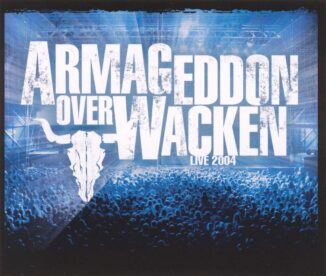
-
IRON MAIDEN - History Of Fear: An Unauthorized Biography - 7.5/107.5/10
Summary
Locomotive Records
Release date: January 30, 2007
User Review
( votes)Iron Maiden is one of the most successful and influential bands in the Heavy Metal genre. To date, Iron Maiden has released 14 studio albums, 2 “Best Of” compilations, 5 live albums, 2 greatest hits compilations, and 2 boxed sets — in the process selling over 70 million albums worldwide. There are numerous bootleg albums, CD’s, VHS tapes, and DVD’s that are no doubt in circulation and are unfortunately unaccounted for, but seem to follow any big name band.
This DVD/biography contains no original music by Iron Maiden. It is not authorized by the band, their management, or their record label. The bottom line is that if you were looking for a “Live” concert type DVD, you won’t find it here. This DVD is more or less a history lesson on Iron Maiden that you can watch instead of read. If you are a diehard fan of Maiden, you will probably want to pick it up to keep your Iron Maiden collection intact.
Here are the contents of this DVD:
PLAY – a short intro that leads into the beginning of Chapter One
CHAPTERS – Legacy of the Beast, Underground Attraction, Running Free, Aces High, New State of Mind, The X Factor
QUIZ – a short 16-question quiz on Iron Maiden
DISCOGRAPHY – albums, singles, bootlegs
BEYOND DVD – Maximum Iron Maiden & Iron Maiden X-Posed
Chapter One – The conception of Iron Maiden is discussed. What was in at the time is touched upon. The pubs/clubs that Maiden played and their fan base is talked about in some detail. The basis for all of this begins when Steve Harris leaves Gypsy’s Kiss and forms his own band. The concept of Iron Maiden was born in 1975 after acquiring Dave Murray (guitarist) and Paul Di’Anno (vocalist).
Chapter Two – The band finally decides they need a demo and in December 1978 they lay down the tracks for “Prowler,” “Invasion,” “Strange World,” and “Iron Maiden” in the recording studio. In December 1979, EMI Records signs Iron Maiden after all other record companies pass on them. The Punk influence on the first two albums is discussed. Di’Anno’s singing is again the topic of discussion by another person of interest. Clive Burr and Dennis Stratton took over on drums and guitar, respectively.
Chapter Three – In February 1980, the first single “Running Free” off their debut album Iron Maiden is released by EMI. Despite receiving hardly any airplay, both the album and single far exceed record company expectations in the charts. “Running Free” and “Remember Tomorrow” were considered Maiden’s strongest material to date. In the spring of 1980, the band began working with well-known producer Tony Platt. Iron Maiden embarks on their first ever European tour supporting USA megastars KISS. Guitarist Dave Murray gets married. Eddie, the bands mascot, is introduced. Returning from the KISS tour, Dennis Stratton decides to leave Iron Maiden. His replacement turns out to be ex-Urchin guitarist, Adrian Smith. Stratton spends time discussing many of the band issues and personality problems amongst themselves in great length. Work begins on their second album Killers with Martin Birch producing. The band played in 15 countries and made their USA debut opening for Metal titans, Judas Priest, during their Killers world tour. Bruce Dickinson is discussed and compared to Paul Di’Anno. Di’Anno’s lifestyle in 1981 wasn’t fitting well with the rest of the band. Di’Anno discusses his downward spiral with alcohol and drugs and the unhappiness that forced him to leave. Behind the scene activities at the Reading Festival in 1981 turned out to be of great importance.
Chapter Four – In October 1981, Bruce Dickinson (ex-Samson vocalist) is chosen as IM’s vocalist. It is suggested by many that the success and ferocity with which IM took off was due to the fact that Bruce had joined the band. In 1982, while in the midst of another one of their sellout tours, their latest album, The Number Of The Beast, gave them their first UK top 10 hit in “Run To The Hills.” From then on, IM could do no wrong for the next ten years. Everything was going right, albums and singles were all Top 10 -– basically with no media exposure whatsoever. More line-up changes occurred. Clive Burr left after Number Of The Beast and Nicko McBrain came in for the Piece Of Mind album and has remained in the band since then. In 1984, Powerslave hit the streets and went straight to #2 even before touring began. Somewhere In Time, their sixth album, was released in September 1986, and after some lengthy touring, IM released Seventh Son Of A Seventh Son, their seventh album in 1988. The band finally got a well-deserved break with nothing scheduled for 1989.
Chapter Five – In January 1990, Maiden starts work on No Prayer For The Dying. Smith (guitarist) informed the group that he was leaving to form his own band. Janick Gers (ex-White Spirit and Gillian guitarist) was available at the time to fill in. After the release of Fear Of The Dark (1992), Dickinson left. Everyone in the band and those closely affiliated within the Maiden circle had a premonition that this was going to occur. There was a three-year gap between Fear Of The Dark and The X Factor (1995), their ninth and tenth albums. During this period, Steve Harris went through a divorce that affected him greatly. Maiden had to prove themselves once again with a new front man (Blaze Bayley). After a long period of touring, the band was back at it, recording their eleventh album, Virtual XI. Only two albums into it with Blaze, and the fans were becoming restless. Harris knew what needed to be done and after going through a long list of prospective singers, it once again came down to Bruce Dickinson being the best choice after all was said and done.
Chapter Six – In 2000, a Top 10 single “The Wicker Man” came from the release of A Brave New World. The vibrant energy that had been missing from IM while Bruce was gone was certainly back. The 2003 album, Dance Of Death, brought IM back to the forefront of Heavy Metal and proved to be a huge success.
Maiden’s longevity and success come from their attitude that the band emulates even today, which is they never chase any trends. They can get away with this laissez-faire attitude because they are IM and they are good at what they do. Over 25 years and 70 million albums sold, Iron Maiden is rightly regarded as the classic British Heavy Metal band.
Interviews: Martin Blackman (friend of Paul Di’Anno, one of the bands earliest followers), Gary Bushell (journalist), Ian Camfield (Dr. XFM), Chris Clayton (Editor, MetalUK.com), Roland Hyams (Publicist, Iron Maiden), Tony Platt (Producer), Dennis Stratton, Steve Harris, Dave Murray, Paul Di’Anno, Bruce Dickinson.




Be the first to comment